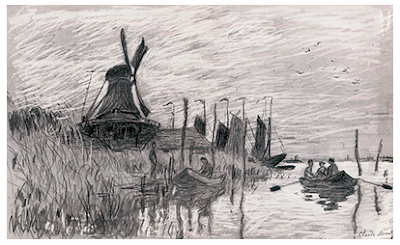After the blog yesterday, we received a number of drawings! THANK YOU members of Fish Hoek Art Society. We'd like more so here is a challenge.
 |
| Vincent Van Gogh |
We're inviting you to send in more drawings on the theme of Autumn. Coloured pencil, graphite, pen, chalk, ink, biro...whatever takes your fancy.
You can do your work in one or more different media, using different tools and mixing and matching if you feel like it. It is whatever takes your fancy and on any colored paper (it is not one of those challenging with straightjacket rules!) and we'd like you to find a subject that appeals to you.
Remember that the paper plays a big role in the success of your drawing. Some papers work much better than others - especially with pencil - and a coloured paper can give you a bit of extra pizazz (as we saw in Rob's feline portrait yesterday) especially if you used dark AND light strokes.
If Autumn doesn't sound inspirational, then give us Summer, the Sea, Trees - we really don't mind. We'd just like you to take out your sketchbook and bring something to life.
Below there are a selection of images 'borrowed' from the internet all of which were created by well known artists and illustrate different attitudes and approaches to a drawing.
We'll start with one of the most minimal works - but my goodness, if you remember how Picasso looked in his youth, you'll realise how few lines he needed to capture his own image.
 |
| Pablo Picasso |
Nearly a century later, it is Lucian Freud who gives us a simple but very effective portrait. Whereas Picasso relied on line and a single dark patch, Freud uses lines and dots to sculpt her face. But, it is the clarity of those eyes with their reflected light that mesmerize us.
 |
| Lucian Freud |
 |
| WMJ Turner |
This bucolic sketch could have been Constable but it is that fabulous colourist, Turner. Again this is done essentially line and probably on the spot. You have cameras so if that autumnal weather looks as though it's going to take a miserable turn, snap your subject on a cellphone or camera and settle down in the comfort of your own home and bring your subject back to life.
I've always had a soft spot for this excellent French artist, below. Naturally being a woman in a man's world she was somewhat overlooked. A mistake! |
| Mary Cassatt |
 |
| Mary Cassatt |
 |
| Beatrix Potter |
 |
| Vincent Van Gogh |
Did Van Gogh give us his best when his spirit was tortured? Perhaps. His portrait at the top of the page is a fresh drawing in two colours. Lines, dobs, dots and splashes: Van Gogh follows the planes with his marks to form a very convincing self portrait. Above is a simple canal scene in his homeland - with a clever composition that keeps bringing the eye back to the boat and occupants on the right side.
I quote from the Van Gogh Museum:
Vincent van Gogh drew thousands of images to better his skills and to fulfill leisure time. He completed over 1,000 drawings, which are known of, from 1877 to 1890. Van Gogh saw drawing as a necessary task to build a foundation as an artist and to study form and movement. However, as he describes, in many of his letters, he also used drawing as an outlet for his depression.
There is it again: "A necessary task to build a foundation as an artist..."
But thousands of us give our best when we are happy, when enthusing about a scene or an image, when life is going fairly well.
So another lesson for us lesser folk, is to find our subject and get comfortable and serene to put it down on paper. If you're suffering angst, give it a miss today and try tomorrow.
Let's put a time limit on this drawing challenge. Two weeks.
Send us your drawings by 05 MAY 2021
either to:
zwets@mweb.co.za or noninichols@gmail.com








